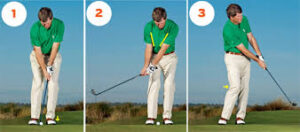Have you ever kept track of the number of times that you have to make a chip during a round of golf? Weekend Warriors don’t hit a lot of Greens In Regulation but they lose a lot more strokes “missing” a chip or chipping outside of 5 feet and end up with a 2 or 3 putt hole. Fortunately Chipping is the easiest stroke to fix with the right coaching. I saw Peter Jacobsen, a PGA Pro promoting a Cleveland Wedge where he offered this simple tip.
Your 2 to 20 yard wedge shot is NOT a full body swing shot. You actually make this shot with a limited spread of your feet (as balance is not an issue with a light swing) and with an open stance to ensure that you keep your weight forward on your leading leg as you swing directly up your target line. There is no need for weight shift as the weight of your club is doing all the work. You are basically swinging your arms (like a pendulum) hanging from the right side of your chest (for right handed clubs). There is very little weight transfer in a chip. You want to hit the ball before you skim the grass so you need to setup with the ball directly opposite the inside of your trailing heal.

Pressure forward, backswing enough to let your club do the work and follow through with your hips
Key for Successful Chipping
1/ Line up your chip and move close to your ball to make a few practice swings.
- Chipping is easy if you make a few practice swings to “feel” the amount of swing needed to hit and run up close to the pin.
- Watch where your club is impacting the grass as you want the starting point to be just after your ball position.
- You are not trying to take a divot but you do want make a shallow sweep through the grass after your ball position.
- Let the weight of your club do all of the work as your hips follow through with the swing.
2/ Keep your head still through the back swing and follow through as you swing with a low arc like a putting stroke except with a longer swing and longer follow through with your hips and arms.
3/ Your goal is to bottom out your club AFTER you impact the ball
4/ Your swing direction should be directly up your target line.
You will never be a great chipper unless you practice with each of your preferred chipping clubs to learn the distance that each amount of swing will make your ball fly and roll-out. The higher the loft, the shorter the roll-out. Practice with your GOLFSTR+ on your trailing arm to limit wrist lag in your backswing as you make your pendulum swing with your arms. Buy one today at www.golfstr.com






